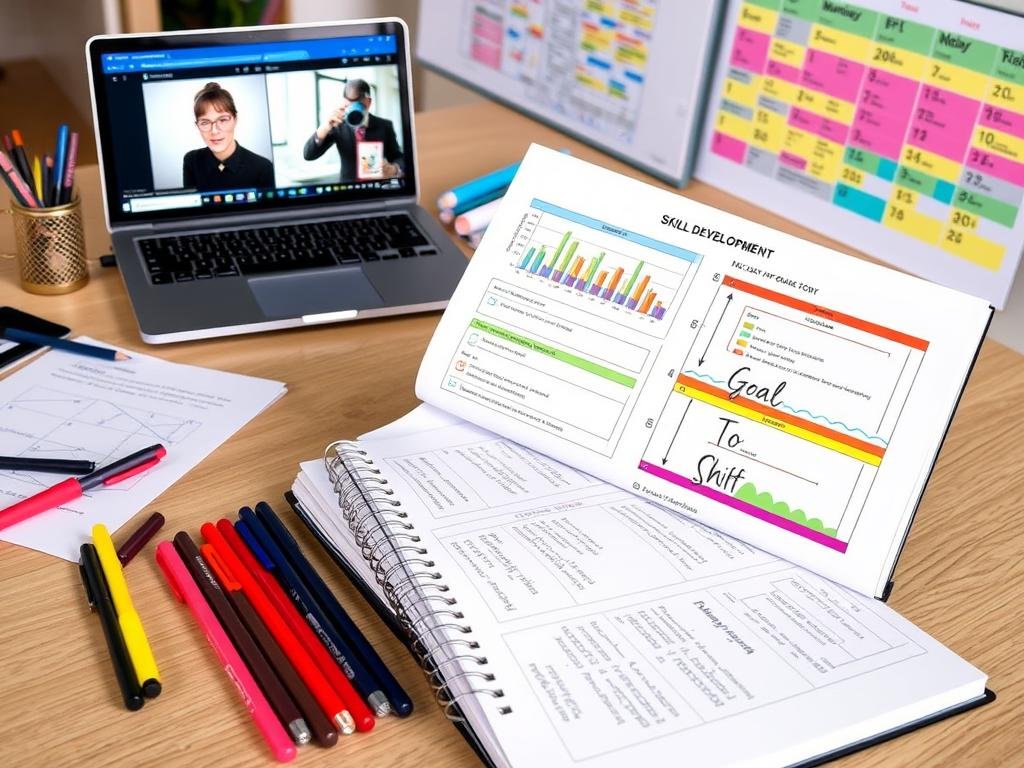Do you feel like your career has stagnated, or are you simply looking to take the next step in your professional journey? Crafting a comprehensive professional development plan can be the key to unlocking your full potential and propelling your career forward. But where do you even begin?
A professional development plan is an ever-changing document that assesses your current skill set, helps you set career goals, create strategies, and uncover resources that will help you reach them. It is a tool that can streamline your career goals and outline your current skills, knowledge, goals, and the steps you need to take to achieve these goals. Creating a professional development plan is crucial in the modern job market, as it allows you to take control of your career advancement, skill enhancement, and personal growth.
Key Takeaways
- A professional development plan is a dynamic document that helps you assess your skills, set career goals, and outline strategies to achieve them.
- Creating a plan allows you to take charge of your career advancement, skill enhancement, and personal growth.
- The plan should include long-term, mid-term, and short-term goals, as well as strategies and resources to help you reach them.
- Continuously tracking your progress and adjusting the plan as needed is crucial to keeping your career development on track.
- Leveraging training programs, mentorship opportunities, and continuing education can be valuable in achieving your professional development goals.
What is a Professional Development Plan?
A professional development plan is a document that outlines your current skills, knowledge, and career goals, along with the steps you need to take to achieve those objectives. It’s an ever-evolving plan that should be updated as your priorities, surroundings, and aspirations change over time.
Defining a Professional Development Plan
The process of creating a professional development plan involves several key elements:
- Self-assessment to identify your strengths, weaknesses, and areas for improvement
- Goal-setting to define specific, measurable, achievable, relevant, and time-bound (SMART) career goals
- Strategy development to determine the best approaches and resources to help you reach your goals
- Timeline creation to establish a clear roadmap for your professional growth
- Progress tracking to monitor your development and make adjustments as needed
By following this structured approach, you can create a comprehensive professional development plan that will guide your career path and help you reach your full potential.

“A well-thought-out and clear Professional Development Plan (PDP) helps identify career goals leading to desired jobs or professions.”
According to recent studies, 61% of professionals find a professional development plan important for mapping out their career goals and aspirations. Furthermore, 49% of professionals have self-assessed their strengths and weaknesses before creating a professional development plan, and 72% have identified their key strengths before setting their career development goals.
The Importance of Professional Development
In today’s competitive job market, professional development has become increasingly crucial for career growth and skill enhancement. By continuously improving your skills and keeping up with industry trends, you can position yourself as a more valuable employee, increase your job satisfaction, and become more adaptable to changes in the workplace.
Furthermore, the cost of replacing an employee can be upwards of twice their annual salary, so investing in professional development can also benefit employers by creating a more efficient and skilled workforce. Research shows that employers offering professional development opportunities can lead to higher retention rates, as it demonstrates a commitment to their employees’ growth and development.
Professional development encompasses a wide range of learning opportunities, from training courses and professional certifications to workshops and conferences. By setting SMART (specific, measurable, attainable, relevant, time-based) goals and making learning a habit, you can effectively organize your time and achieve long-lasting positive change in your career.
| Benefit | Impact |
|---|---|
| Increased Job Security | Professional development can enhance your job performance and potential for career advancement, ultimately increasing your job security. |
| Improved Career Prospects | Workers who prioritize their professional development experience faster career progression and access to a broader range of lucrative employment opportunities. |
| Attractive to Employers | Employers who invest in professional development programs can attract top talent by showcasing a commitment to employee growth and development. |
By embracing the power of professional development, you can not only improve your own career prospects but also contribute to the overall success of your organization. Whether you’re looking to acquire new skills, stay ahead of industry trends, or unlock your full potential, investing in your professional development is a smart and strategic move that can pay dividends throughout your career.
Steps to Create a Professional Development Plan
Building a comprehensive professional development plan is a crucial step in advancing your career and unlocking your full potential. The process begins with a thorough self-assessment to evaluate your personal and professional interests, current knowledge, and skill set. This introspective exercise will help you identify areas for improvement and set realistic, actionable goals.
Self-Assessment and Goal Setting
When setting goals, it’s essential to use the SMART (Specific, Measurable, Achievable, Relevant, and Time-Bound) framework. This approach ensures your objectives are clear, measurable, and aligned with your career aspirations. Additionally, it’s wise to establish a mix of short-term, mid-term, and long-term goals to keep you motivated and on track throughout your professional development journey.
| SMART Goal Component | Description |
|---|---|
| Specific | Your goal should be clear and unambiguous, with a specific outcome in mind. |
| Measurable | Your goal should have quantifiable metrics to track progress and success. |
| Achievable | Your goal should be challenging yet realistic, based on your current resources and capabilities. |
| Relevant | Your goal should be aligned with your overall career planning and professional development needs. |
| Time-Bound | Your goal should have a specific timeline for completion, with clearly defined milestones. |
By following this structured approach to goal setting, you can create a professional development plan that is tailored to your unique needs and aspirations, empowering you to reach new heights in your career.
Developing Strategies and Gathering Resources
Crafting a professional development plan is more than just setting goals – it also requires developing effective strategies to help you achieve those objectives. Begin by identifying the specific skills, competencies, or behaviors you want to. Then, explore the various resources and opportunities available to support your growth, such as training programs, workshops, or mentorship initiatives.
One powerful strategy is to leverage your professional network. Reach out to colleagues, industry peers, or experienced mentors who can provide guidance, share their expertise, and connect you with relevant learning opportunities. Online platforms and virtual communities can also be valuable resources for skill development and knowledge sharing.
Creating a Timeline and Tracking Progress
With your strategies and resources in place, the next step is to create a detailed timeline for your professional development plan. Assign specific milestones and deadlines to each of your goals, ensuring a sense of structure and accountability. Regularly review your progress and be prepared to make adjustments as needed.
Effective performance management is crucial for the success of your professional development plan. Implement mechanisms to track your progress, such as regular check-ins with your manager or self-assessment tools. By monitoring your development, you can identify areas where you may need additional support or resources, and make informed decisions to enhance your overall growth.
| Type of Professional Development Plan (PDP) | Key Focus | Typical Use Case |
|---|---|---|
| Foundational PDP | Understanding roles and responsibilities | Onboarding new hires with a 30-60-90-day plan |
| Leadership PDP | Developing leadership skills | Enhancing strategic thinking, people management, and decision-making for current or aspiring leaders |
| Succession Planning PDP | Preparing for future key business leadership roles | Avoiding operational disruptions by strategically developing employees for future leadership positions |
| Performance Improvement Plan (PIP) | Improving underperforming areas | Outlining specific areas for improvement, achievable goals, and resources to enhance employee performance |
| Technical Skills-Focused PDP | Enhancing or acquiring specific technical skills | Tailoring development to job-related technical requirements, such as IT skills or data analysis |
“86 percent of employees would consider changing jobs if it meant more opportunities for professional development.”
Professional Development Plan for professional development plan
Crafting a comprehensive professional development plan is an essential step in taking control of your career growth and achieving your professional goals. By assessing your current skills, setting SMART goals, developing strategies, and tracking your progress, you can unlock your full potential and position yourself for success in the workplace.
To create an effective professional development plan, start by conducting a thorough self-assessment using tools like the Big Five, Myers-Briggs Type Indicator, or DISC personality test. This will help you identify your strengths, weaknesses, and areas for improvement. Once you have a clear understanding of your current capabilities, you can set SMART (Specific, Measurable, Achievable, Relevant, and Time-bound) goals that align with your career aspirations and organizational objectives.
| Goal Type | Example |
|---|---|
| Long-term | Obtain a management position within the next 3-5 years |
| Mid-term | Complete a leadership development program in the next 12-18 months |
| Short-term | Improve public speaking skills by attending a workshop within the next 6 months |
Next, develop strategies to achieve your goals, such as seeking out learning opportunities, building a professional network, or taking on new projects. Identify the resources and support you’ll need, including seminars, workshops, online courses, or guidance from mentors or colleagues.
Remember, your professional development plan is a living document that should evolve as your goals and priorities change. Investing in your continued growth and improvement will not only benefit you but also your employer, making you a more valuable and adaptable asset in the ever-changing job market.
“A clear professional development plan helps individuals assess how far they’ve come in reaching their professional goals.”
Conclusion
In conclusion, creating a professional development plan is a crucial step in taking control of your career growth and achieving your professional goals. By assessing your current skills, setting SMART goals, developing strategies, and tracking your progress, you can unlock your full potential and position yourself for success in the workplace. Investing in your continued growth and improvement will not only benefit you but also your employer, making you a more valuable and adaptable asset in the ever-changing job market.
Remember, your professional development plan is a living document that should evolve as your goals and priorities change, so be sure to regularly review and update it to ensure it remains a valuable tool for your career advancement. By taking this proactive approach to your personal growth and workforce development, you can unlock new opportunities, enhance your job satisfaction, and contribute more effectively to the success of your organization.
FAQ
What is a professional development plan?
Why is creating a professional development plan crucial in the modern job market?
What are the key steps in creating a professional development plan?
How can a professional development plan benefit both the employee and the employer?
How often should you review and update your professional development plan?
Source Links
- Write a Professional Development Plan in 6 Steps [2024] • Asana – https://asana.com/resources/professional-development-plan
- 5 Steps fo Create an Effective Professional Development Plan – https://www.award.co/blog/professional-development-plan
- Professional Development Plan – https://hr.wisc.edu/professional-development/develop-your-career/employee-development/professional-development-plan/
- How to Create a Professional Development Plan – https://www.wgu.edu/blog/create-professional-development-plan2302.html
- What is a Professional Development Plan? Examples & Template – https://www.sefe-mt.com/careers/blog/what-is-a-professional-development-plan-pdp-examples-template/
- Personal vs. Professional Development Plans – https://learning.linkedin.com/resources/career-development/personal-vs-professional-development
- The importance and benefits of professional development – https://www.upskillist.pro/blog/the-importance-and-benefits-of-professional-development/
- Blog post >> Visit the Paycom blog to learn more – https://www.paycom.com/resources/blog/professional-development/
- 6 Steps to Create a Professional Development Plan • Toggl hire – https://toggl.com/blog/examples-of-a-professional-development-plan
- How to Write a Professional Development Plan: 6 Steps – https://www.flexjobs.com/blog/post/create-a-professional-development-plan/
- How To Design a Professional Development Plan for Career Growth – https://blog.hubspot.com/marketing/professional-development-plan
- 7 Ways You Can Achieve Your Professional Development Goals – https://online.hbs.edu/blog/post/professional-development-goals
- [Free] Professional Development Plan Template and Guide for 2024 – https://www.aihr.com/blog/professional-development-plan-template/
- Chapter 11: Professional Development – Conclusion and Resources – https://2009-2017.state.gov/m/a/os/45726.htm
- How to Create a Professional Development Plan (+template) – https://www.effy.ai/blog/professional-development-plan
- Creating an Employee Development Plan: Steps & Template – Continu – https://www.continu.com/blog/employee-development-plan






